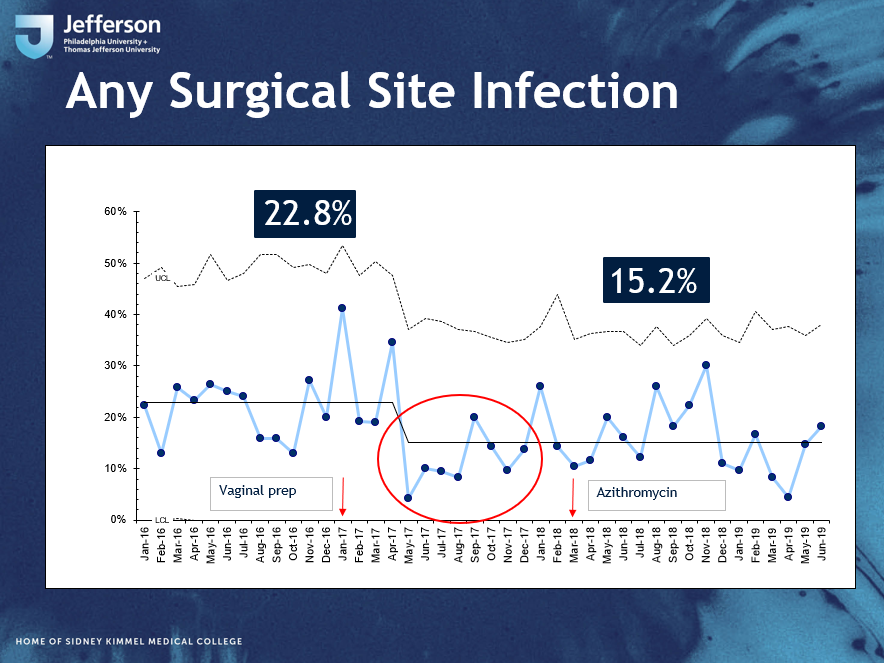Impact of vaginal cleansing and azithromycin on cesarean surgical site infections
Principal investigator Johanna Quist-Nelson, MD, was inspired to complete the study during her training after observing how difficult it was for patients who experienced wound infections after cesarean.
The American College of Obstetricians and Gynecologists’ (ACOG) 2020 Virtual Conference starts this Friday, Oct. 30, with presentations by preeminent experts in ob/gyn. Presentations will be given through Saturday, Oct. 31. Check out the full schedule here and register to attend. It will stream live and on-demand.
Implementation of vaginal cleansing for cesarean delivery decreased the surgical site infection (SSI) rate by 33% over a 4-year period at one Pennsylvania hospital, according to a quality improvement study presented at the American College of Obstetricians and Gynecologists (ACOG) 2020 Virtual Conference.
However, the addition of intravenous azithromycin did not result in any additional change in SSI rate.
Figure 1. Any Surgical Site Infection

“Nonetheless, we continue to support the use of azithromycin at our hospital, given the strong evidence from the previous randomized controlled trials,” said principal investigator Johanna Quist-Nelson, MD, who at the time of the study was a maternal-fetal medicine fellow at Thomas Jefferson University Hospital in Philadelphia.
Dr. Quist-Nelson was inspired to complete the study during her training after observing how difficult it was for patients who experienced wound infections after cesarean. “Often these patients are in pain, have trouble breastfeeding and sometimes need to be re-admitted,” she said. “This can lead to poor bonding of the maternal-infant dyad and increase the risk for postpartum depression.”
Principal investigator Johanna Quist-Nelson, MD

After Dr. Quist-Nelson and her team noted a high rate of SSI, they reviewed evidence of low-risk interventions that could decrease that risk of wound infections, they sought to implement them.
“We aimed to reduce our SSI rate by 30% in a high-risk population by sequential implementation of vaginal cleansing and azithromycin for women who underwent a cesarean delivery after having labored or experienced prelabor rupture of membranes (PROM),” Dr. Quist-Nelson told Contemporary OB/GYN.
The study consisted of 1,033 patients who delivered via cesarean during labor or after PROM at Thomas Jefferson Hospital from 2016 to 2019.
“The hospital serves an urban population, in which the majority of patients come from racial backgrounds that experience systemic racism,” Dr. Quist-Nelson said.
At the start of the study, the investigators initiated vaginal cleansing routinely for women in labor or with PROM prior to cesarean, and15 months before the addition of azithromycin to the same population.
All providers were trained in vaginal cleansing, which comprised 30 seconds of cleaning the perineum from the anterior to posterior direction using a sponge stick with 10% povidone-iodine or the sponge portion of a 4% chlorhexidine scrub brush.
Cleansing was performed at the time of urinary catheter placement in the operating room using povidone-iodine supplies that were also available prior to vaginal delivery.
Azithromycin 500 mg IV was ordered if cesarean delivery was planned within 1 hour. “Routine pre-operative antibiotics -- generally weight-based dosing of cefazolin -- were given preferentially prior to administration of azithromycin,” Dr. Quist-Nelson said. “The ideal timing of azithromycin was within 1 hour prior to incision, although the timing was dependent on the urgency of the cesarean delivery.”
Vaginal cleansing alone decreased the SSI rate by 33%, from 22.8% to 15.2%, over the study period.
“It was surprising to our team that azithromycin did not further lower our post-cesarean SSI rate,” Dr. Quist-Nelson said. “We had hoped to see a further decrease in our population.”
That implementation of vaginal cleansing and azithromycin are feasible and effective, according to Dr. Quist-Nelson, who is now an assistant professor of maternal-fetal medicine at the University of North Carolina in Chapel Hill.
To further decrease SSI with vaginal cleansing, she recommends that healthcare facilities take advantage of supplies already existing on their labor floor.
“Before we began the study, our hospital already had iodine-soaked sponges that came in packets,” Dr. Quist-Nelson said. “We simply ordered more of these packets and placed them prominently in the operating room.”
However, merely putting supplies in place is not enough. Providers still needed reminders after implementation in order to increase compliance. “Using a reminder system in the electronic medical record (EMR) was very helpful for our providers to remember to order azithromycin for the appropriate patients,” Dr. Quist-Nelson said.
The ACOG 2020 Virtual Conference will be held on October 30 and 31 from noon to 4 pm ET. Register here.
__
Dr. Quist-Nelson reports no relevant financial disclosures.
S1E4: Dr. Kristina Adams-Waldorf: Pandemics, pathogens and perseverance
July 16th 2020This episode of Pap Talk by Contemporary OB/GYN features an interview with Dr. Kristina Adams-Waldorf, Professor in the Department of Obstetrics and Gynecology and Adjunct Professor in Global Health at the University of Washington (UW) School of Medicine in Seattle.
Listen
